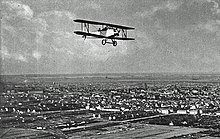Focke-Wulf S 24
| Focke-Wulf S 24 | |
|---|---|
 Focke-Wulf S 24 with Walter NZ 60 |
|
| Type: | Sport plane |
| Design country: | |
| Manufacturer: | |
| First flight: |
1928 |
| Number of pieces: |
31 |
The Focke-Wulf S 24 “ Kiebitz ” was a two-seater, aerobatic biplane sports aircraft made by Focke-Wulf- Flugzeugbau AG in 1928. A special feature of the aircraft were the wings that could be folded back. So the plane could be pulled or transported by an ordinary car.
history
The Focke-Wulf S 24 was an after-work project by the designers Paul Klages and Wohlberg, who worked at Focke-Wulf and designed the aircraft for Gerd Achgelis . At the end of 1929 it became an official Focke-Wulf model. With a version with additional tanks, Edzard and Max Middendorf set a world record for range of 1601 km in their class on August 20, 1929. Gerd Achgelis won the German aerobatic championship in 1931 on this type of aircraft, an S 24c. A total of 31 machines of this type were sold, including some to China and one to Brazil as a demonstration machine.
construction
- Type: single-engine light-weight sports aircraft
- Wing: braced, single-handled biplane with straight, unstaggered wings. Upper and lower wing in the same size and with the same floor plan. In contrast to many other biplanes of the time, each upper wing half was not attached by an N-post above the fuselage, but rather by two posts, arranged like an inverted V and another single post behind the forward cockpit. The upper wings are connected to the lower wing by an N-post. The wings are braced crosswise with double wires.
- Hull: Hull as a welded tubular steel grille, covered with fabric, only covered with aluminum in the area of the engine
- Chassis: rigid normal chassis. Each main wheel on a split axle, which is raised in the middle and hinged to a three-legged bracket under the fuselage. Rigid abrasive spur .
- Engine: An air-cooled five-cylinder - radial engine Siemens & Halske Sh 13 , were used by the various embodiments of 68 hp (50 kW) to 82 hp (60 kW), or a Walter NZ 60 . A rigid two-bladed wooden propeller was driven .
- Crew: 2 open seats in a row with double rudder.
Technical specifications
| Parameter | Data |
|---|---|
| crew | 2 |
| length | 6.25 m |
| span | 8.90 m |
| Wing area | 19.5 m² |
| height | 2.25 m |
| Empty mass | 365 kg |
| Take-off mass (for aerobatics) | 585 kg |
| drive | air-cooled 5-cylinder radial engine Siemens & Halske Sh 13 with 50 to 60 kW (68 to 82 HP) |
| Top speed | 150 km / h |
| Service ceiling | 3500 m |
literature
- Michael JH Taylor: Jane's Encyclopedia of Aviation . Studio Editions, London 1989, pp. 395 .
- Focke-Wulf "Lapwing" . In: Flight . April 18, 1929, p. 320-21 ( flightglobal.com [accessed March 23, 2008]).
Web links
Individual evidence
- ↑ According to the company tradition of that time, all Focke-Wulf aircraft had internal bird names.
- ↑ Focke-Wulf's birds. FliegerRevue, February 2010, pp. 56–58
- ^ Picture of a "Kiebitz" with a Walter NZ-60 engine in the Pestrý týden (Eng. "Bunte Woche", ISSN 1801-4429) from April 20, 1929


